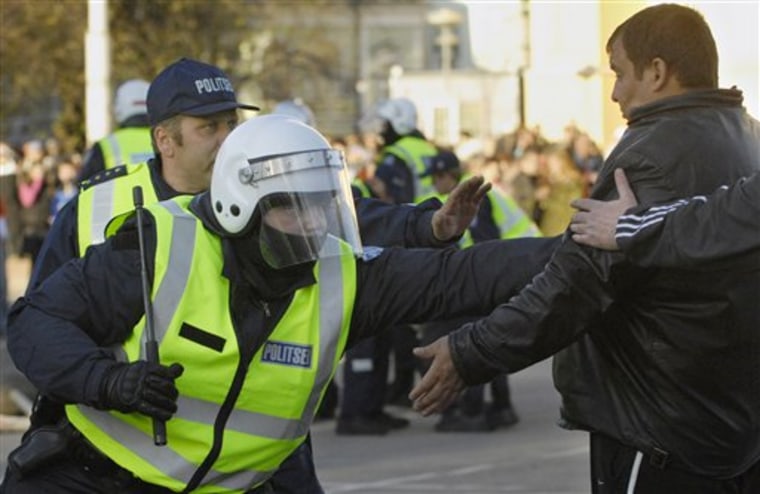Riot police fired rubber bullets in a clash with hundreds of protesters in Estonia's capital Friday, as a second night of unrest broke out over the government's removal of a Soviet war monument.
Police also used a water cannon to hold off protesters, who responded by throwing bottles and rocks. Police said officers fired rubber bullets and around 100 protesters were detained.
Cars passing the site of the clashes, in Tallinn's Freedom Square, honked their horns as a sign of support for the protesters, who are mainly ethnic Russians outraged by the government's decision to remove the Bronze Soldier statue from downtown Tallinn.
Estonia's Russian-speakers — roughly one-third of the country's 1.3 million population — see the monument as a tribute to Red Army soldiers who died fighting the Nazis, but many ethnic Estonians consider it a painful reminder of hardships under Soviet rule.
Earlier, Russian lawmakers called for sanctions against Estonia after authorities removed the memorial.
The unrest followed a decision by the Estonian government to speed up the removal of the 6-foot-tall statue known as the "Bronze Soldier" and exhume the remains of Soviet soldiers buried nearby.
The statue, erected in 1947, was being held at an undisclosed location, said Andreas Kaju, a Defense Ministry adviser. The remains have not yet been exhumed.
Worst riots as independent nation
The rioting overnight Thursday was the worst Estonia has seen in 16 years of independence, leaving one dead and dozens injured, including 12 police officers, said government spokesman Martin Jasko.
About 1,500 protesters rallied peacefully for hours Thursday until a small group tried to break through a police line protecting the monument.
The riots started when protesters clashed with police in a commercial district near the monument. The violence then spread to the winding cobblestoned streets of Tallinn's medieval Old Town.
Angry demonstrators smashed windows and hurled rocks and bottles at police who tried to disperse the crowds with stun grenades. A bus shelter was set on fire as the clashes were followed by vandalism and looting. Some 300 people were detained.
The bronze monument depicts a Red Army soldier in uniform, his helmet in one hand, his head slightly bowed and his rifle slung over his back.
The center-right government had said the monument and the nearby graves should be moved to a cemetery because its location near a busy intersection was not a proper place resting place for the victims.
But critics said the real reason was to pander to nationalist movements in Estonia, to whom the memorial was a symbol of Soviet repression.
Once the remains have been exhumed and identified, they would be moved to the Defense Forces cemetery outside Tallinn, along with the statue, said Andreas Kaju, a Defense Ministry adviser. The statue, erected in 1947, was being held at an undisclosed location, he said.
Excavation work postponed
The government had hoped to begin excavation work on Friday morning, but was forced to postpone it because of the unrest.
When authorities decided to remove the statue, they stepped on one of the few remaining symbols left for minority Russians to revere _ a sense of pride in defeating Nazi Germany.
Both houses of Russia's legislature voted for enacting severe measures against Estonia _ either breaking off diplomatic relations or enforcing economic sanctions.
"The Estonian government has spat on values," Russian news agencies quoted Foreign Minister Sergey Lavrov as saying. "I cannot understand it when people try to lay blame for historical events on somebody, or try to compare communism with Nazism."
Soviet troops invaded the Baltic countries _ Estonia, Latvia and Lithuania _ in 1940, but were pushed out by the Nazis a year later. The Red Army retook them in 1944 and occupied them until the collapse of the Soviet Union in 1991.
Some Tallinn residents said they were not surprised by the riots because ethnic Russians have felt marginalized ever since Estonia split from the Soviet Union.
"This was waiting to happen," said Epp Saar, 43, a Tallinn resident of mixed Estonian and Russian descent. "There has been a feeling for a long time that pressure has been building and things will just explode any day."
Many Russian-speakers complain of discrimination in Estonia, where strict language laws make it hard to get jobs or citizenship without proficiency in Estonian. Some Russian-speakers who were born in Estonia are either unable or unwilling to become citizens because of the language requirements.
The European Commission said it regretted the death of a demonstrator, but said it could not interfere in the matter. Estonia joined the European Union in 2004.
In New York, U.N. Secretary-General Ban Ki-moon appealed "to all concerned to deal with the issues at hand in a spirit of respect and conciliation," U.N. spokeswoman Michele Montas said.
